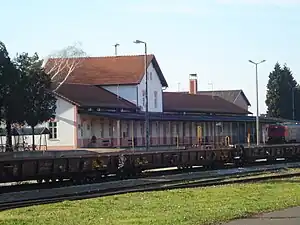L101 railway (Croatia)
The Čakovec–Mursko Središće railway, officially designated L101 railway, is a 17.942-kilometre (11.149 mi) railway line in Croatia connecting the cities of Čakovec and Mursko Središće.[maps 1] The railway line links to the Slovene railway line to Lendava to the north of Mursko Središće.[1] In Čakovec, the railway also connects to the M501 to Budapest and Ljubljana and to the R201 to Varaždin and the rest of the Croatian railway network.[2]
| Čakovec–Mursko Središće railway | ||||||||||||||||||||||||||||||||||||||||||||||||||||||||||||||||||||||||||||||||||
|---|---|---|---|---|---|---|---|---|---|---|---|---|---|---|---|---|---|---|---|---|---|---|---|---|---|---|---|---|---|---|---|---|---|---|---|---|---|---|---|---|---|---|---|---|---|---|---|---|---|---|---|---|---|---|---|---|---|---|---|---|---|---|---|---|---|---|---|---|---|---|---|---|---|---|---|---|---|---|---|---|---|---|
 Čakovec railway station | ||||||||||||||||||||||||||||||||||||||||||||||||||||||||||||||||||||||||||||||||||
| Overview | ||||||||||||||||||||||||||||||||||||||||||||||||||||||||||||||||||||||||||||||||||
| Line number | L101 (HŽ) | |||||||||||||||||||||||||||||||||||||||||||||||||||||||||||||||||||||||||||||||||
| Technical | ||||||||||||||||||||||||||||||||||||||||||||||||||||||||||||||||||||||||||||||||||
| Line length | 17.9 km (11.1 mi) | |||||||||||||||||||||||||||||||||||||||||||||||||||||||||||||||||||||||||||||||||
| Track gauge | 1435 mm | |||||||||||||||||||||||||||||||||||||||||||||||||||||||||||||||||||||||||||||||||
| Operating speed | 60 km/h (37.3 mph) max. | |||||||||||||||||||||||||||||||||||||||||||||||||||||||||||||||||||||||||||||||||
| ||||||||||||||||||||||||||||||||||||||||||||||||||||||||||||||||||||||||||||||||||
Route is non-electrified and single-tracked.[3][4] The maximum permitted speed throughout the entire L101 railway is 60 kilometres per hour (37 miles per hour).[5] The route was built in 1889 as Zalaegerszeg-Čakovec railway, but in 1945, after World War II, the route was dismantled between Lendava and Rédics. Slovenian Railways plans to rebuild the section between Lendava and Rédics.[6]
See also
Maps
- Overview map of the Čakovec-Mursko Središće railway (Map). OpenStreetMap. Retrieved December 11, 2013.
References
- "Odluka o razvrstavanju željezničkih pruga" [Decision on Classification of Railways]. Narodne novine (in Croatian). Government of Croatia. 2006.
- "Karta pruga" [Railway map] (in Croatian). Croatian Railways. Archived from the original on 2013-10-17.
- "Annex 3.3. Types of Lines". Network Statement 2014. HŽ Infrastruktura. p. 1. Archived from the original (PDF) on 2013-05-03.
- "Annex 3.6. Electrification System". Network Statement 2014. HŽ Infrastruktura. p. 1. Archived from the original (PDF) on 2013-05-03.
- "Annex 3.14. Distance Between Establishments and Maximum Permitted Line Speed". Network Statement 2014. HŽ Infrastruktura. pp. 34–35. Archived from the original (PDF) on 2013-05-03.
- "Minister Patrick Vlačič holds talks with Hungarian State Secretary Pál Völner in Budapest". 22 November 2010. Retrieved 19 March 2016.